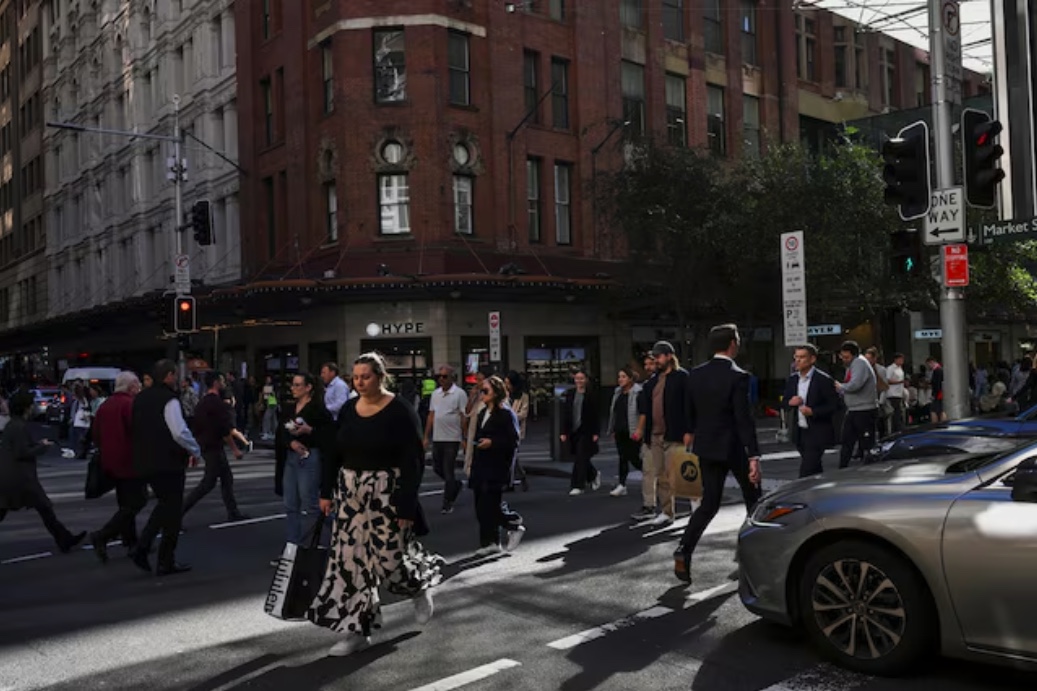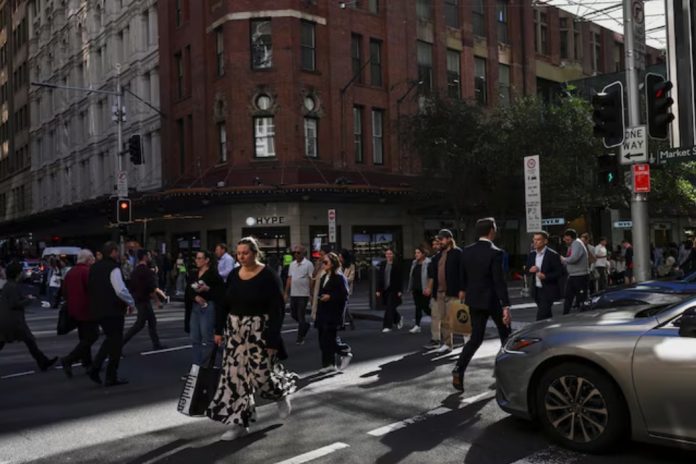การเติบโตของการจ้างงานในออสเตรเลียชะลอตัวลงในเดือนตุลาคมหลังจากมีการขยายตัวแข็งแกร่งมาก่อนหน้านี้ แต่ระดับการว่างงานยังคงต่ำ และแนวโน้มพื้นฐานของตลาดแรงงานยังคงแข็งแกร่ง ซึ่งบ่งชี้ว่าอาจไม่มีความเร่งด่วนในการลดอัตราดอกเบี้ย
ตลาดมีการตอบสนองเพียงเล็กน้อย โดยค่าเงินดอลลาร์ออสเตรเลียยังคงอยู่ที่ 0.6485 ดอลลาร์สหรัฐ และฟิวเจอร์สพันธบัตรระยะเวลา 3 ปียังคงไม่เปลี่ยนแปลงที่ 95.78 ตลาดยังคงคาดการณ์ว่าออสเตรเลียจะเริ่มปรับลดอัตราดอกเบี้ยครั้งแรกในเดือนพฤษภาคมหรือกรกฎาคมปีหน้า
ข้อมูลจากสำนักสถิติออสเตรเลียเมื่อวันพฤหัสบดีแสดงให้เห็นว่า การจ้างงานสุทธิเพิ่มขึ้น 15,900 ตำแหน่งในเดือนตุลาคม เมื่อเทียบกับเดือนกันยายนซึ่งมีการปรับแก้เป็น 61,300 ตำแหน่ง การเพิ่มขึ้นนี้นับเป็นตัวเลขที่น้อยที่สุดในรอบ 7 เดือนและต่ำกว่าที่ตลาดคาดการณ์ว่าจะเพิ่มขึ้น 25,000 ตำแหน่ง แต่การเติบโตของการจ้างงานต่อปียังคงแข็งแกร่งที่ 2.7%
อัตราการว่างงานคงอยู่ที่ระดับต่ำทางประวัติศาสตร์ที่ 4.1% ซึ่งไม่เปลี่ยนแปลงมาตั้งแต่เดือนมิถุนายน ขณะที่อัตราการมีส่วนร่วมลดลงเล็กน้อยเป็น 67.1% จากระดับสูงสุดตลอดกาลที่ 67.2%
ซู-หลิน ออง หัวหน้านักเศรษฐศาสตร์จาก RBC Capital Markets กล่าว “ผมคิดว่ามันยืนยันถึงตลาดแรงงานที่แข็งแกร่งและมั่นคง ซึ่งยังคงมีลักษณะตึงตัวอยู่ ดังนั้นแม้ว่าตัวเลขการจ้างงานหลักจะพลาดเป้า… แต่ก็ยังถือว่าเป็นผลลัพธ์ที่ดีโดยรวม” เขากล่าวต่อว่า “จากมุมมองของธนาคารกลางออสเตรเลีย ตลาดแรงงานอาจกำลังดำเนินไปได้ดีกว่าที่คาดไว้… เราเห็นว่าต้องมีการคลายความตึงตัวของตลาดแรงงานนี้ลงก่อนที่พวกเขาจะรู้สึกสบายใจในการลดอัตราดอกเบี้ย”
ธนาคารกลางออสเตรเลียคงนโยบายดอกเบี้ยไว้เป็นเวลาหนึ่งปีแล้ว โดยตัดสินว่าอัตราดอกเบี้ยเงินสดที่ระดับ 4.35% ซึ่งเพิ่มขึ้นจาก 0.1% ในช่วงการแพร่ระบาดนั้นสูงพอที่จะนำเงินเฟ้อเข้าสู่ช่วงเป้าหมายที่ 2-3% ขณะที่ยังรักษาระดับการจ้างงานที่แข็งแกร่ง
ด้วยตลาดแรงงานที่แข็งแกร่งเกินคาด โอกาสในการลดอัตราดอกเบี้ยระยะสั้นจึงมีน้อย ธนาคารกลางได้กล่าวว่านโยบายการเงินจะยังคงอยู่ในระดับที่เข้มงวด จนกว่าจะมีความมั่นใจว่าเงินเฟ้อจะเคลื่อนไหวเข้าสู่เป้าหมายได้อย่างยั่งยืน
อัตราเงินเฟ้อทั่วไปชะลอตัวลงที่ 2.8% ในไตรมาสที่สาม แต่เป็นเพียงเพราะการคืนเงินค่าบริการไฟฟ้าของรัฐบาล ขณะที่อัตราเงินเฟ้อพื้นฐานยังคงสูงอยู่ที่ 3.5%
ตลาดคาดการณ์โอกาสเพียง 10% ที่ธนาคารกลางอาจลดอัตราดอกเบี้ยในการประชุมครั้งสุดท้ายของปีนี้ในวันที่ 10 ธันวาคม และมีโอกาสเพียง 28% ที่จะปรับลดในครั้งถัดไปในเดือนกุมภาพันธ์
รายงานการจ้างงานระบุว่าชั่วโมงการทำงานเพิ่มขึ้น 0.1% ในเดือนตุลาคม ซึ่งเป็นการเพิ่มขึ้นต่อเนื่องเป็นเดือนที่ห้า ขณะที่อัตราการมีงานทำต่ำกว่าศักยภาพลดลง 0.1 จุดเป็น 6.2%
โทนี่ ซิคามอร์ นักวิเคราะห์จาก IG กล่าวว่า การเติบโตของการจ้างงานที่อ่อนลงนั้นแสดงถึงสัญญาณเล็กน้อยของการผ่อนคลายภายในตลาดแรงงานที่แข็งแกร่งอย่างยิ่ง
“มันเปิดโอกาสให้ธนาคารกลางมีพื้นที่เพียงพอในการมุ่งเน้นไปที่เงินเฟ้อต่อไปและคงอัตราดอกเบี้ยในระดับที่เข้มงวดจนถึงสิ้นปี โดยไม่มีสัญญาณการเสื่อมโทรมที่สำคัญในตลาดแรงงาน” ซิคามอร์กล่าว
Australia’s employment growth slows but no rate cuts expected until mid 2025

Australia’s employment growth slowed in October after a strong run, but the jobless rate stayed low and underlying trends remained relatively healthy, suggesting there is little rush to cut interest rates.
There was muted market reaction, with the Australian dollar little changed at $0.6485 and three-year bond futures also unchanged at 95.78. Markets maintained bets that a first easing in Australia would come most likely in May or July next year.
Figures from the Australian Bureau of Statistics on Thursday showed net employment rose 15,900 in October from September, when they jumped by a revised 61,300.
That was the smallest increase in seven months and came in under market forecasts for a 25,000 rise, but annual jobs growth still ran at a strong 2.7%.
The jobless rate held at a historically low 4.1%, where it has been since June, while the participation rate edged down to 67.1% from an all-time high of 67.2%.
“I think it does nothing really but underscore a pretty resilient, firm labour market that continues to err on the tight side. So despite a miss on headline employment… it is still a very decent result all around, ” said Su-Lin Ong, chief economist at RBC Capital markets.
“I think from the perspective of the Reserve Bank, the labour market is probably tracking better than they thought… we would argue that… you need to see some loosening up in this labour market before they will feel comfortable cutting rates”
The RBA has held its policy steady for a year now, judging the current cash rate of 4.35% – up from 0.1% during the pandemic – is restrictive enough to bring inflation to its target band of 2-3% while preserving employment gains.
With the labour market surprisingly strong, the prospects of a near-term rate cut are slim. The central bank has said monetary policy will stay restrictive until it is confident inflation is moving sustainably to target.
Headline inflation slowed to 2.8% in the third quarter but that was only due to government electricity rebates. Underlying inflation remained high at 3.5%.
Markets imply just a 10% chance the RBA might cut at the last meeting of the year on Dec. 10, and only a 28% probability of a move at its following meeting in February.
The job report showed hours worked rose 0.1% in October, up for a fifth straight month, while the underemployment rate eased 0.1 percentage point to 6.2%.
Tony Sycamore, analyst at IG, said the softer jobs growth offered some modest signs of cooling within an exceptionally resilient labour market.
“It provides the central bank with the breathing room to maintain its focus on inflation and keep rates in restrictive territory into year-end, all without any significant signs of deterioration in the labour market,” said Sycamore.
By Stella Qiu, Reuters

















